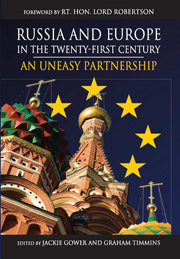Book contents
- Frontmatter
- Contents
- List of Contributors
- Acknowledgements
- List of Abbreviations/Acronyms
- Foreword Russia and Europe
- Preface
- Introduction Russia and Europe: What Kind of Partnership?
- PART 1 Russia looking West
- PART 2 Europe looking East
- PART 3 Partnership in Practice
- Chapter 13 EU-Russia Political Relations: Negotiating the Common Spaces
- Chapter 14 The Economic Relationship between Russia and the EU: History and Prospects
- Chapter 15 Russia and the European Security Governance Debate
- Conclusion Russia and Europe: An Uneasy Partnership 289
- Index
- More Titles in this series
Chapter 14 - The Economic Relationship between Russia and the EU: History and Prospects
from PART 3 - Partnership in Practice
Published online by Cambridge University Press: 05 March 2012
- Frontmatter
- Contents
- List of Contributors
- Acknowledgements
- List of Abbreviations/Acronyms
- Foreword Russia and Europe
- Preface
- Introduction Russia and Europe: What Kind of Partnership?
- PART 1 Russia looking West
- PART 2 Europe looking East
- PART 3 Partnership in Practice
- Chapter 13 EU-Russia Political Relations: Negotiating the Common Spaces
- Chapter 14 The Economic Relationship between Russia and the EU: History and Prospects
- Chapter 15 Russia and the European Security Governance Debate
- Conclusion Russia and Europe: An Uneasy Partnership 289
- Index
- More Titles in this series
Summary
The Legacy of the Soviet Period on Russia's International Trade Structure
Russia's Communist experience resulted not only in political, but also in economic isolation from the West. Trade and financial transactions with the non-Communist world were not ruled out per se – indeed the Soviet authorities carefully nurtured a reputation for being reliable debtors and were not averse to tapping foreign financial markets when needed. Nevertheless, the doctrine of economic self-sufficiency (autarky) and the country's adversarial relationship with the West quickly reduced economic contacts to a minimum. The situation did not change radically after the victory in World War II; indeed, the extension of Soviet power over central Europe allowed the Union of Soviet Socialist Republics (USSR) access to supplies of advanced mechanical equipment (notably from Eastern Germany or the Czech Republic) and to agricultural produce, giving new life to the system. The USSR did not join any of the major international economic institutions (such as International Monetary Fund (IMF) and the World Bank), and prevented its satellites from participating in the Marshall Plan and in the organisation that ran it, which later developed into the Organization for Economic Cooperation and Development (OECD). Soviet-bloc countries instead joined the Council of Mutual Economic Assistance (Comecon), whose transferable rouble system offered the Soviet Union the opportunity to base trade with its satellites on a favourable monetary regime, unconnected to world prices and not dependent on hard currency.
- Type
- Chapter
- Information
- Russia and Europe in the Twenty-First CenturyAn Uneasy Partnership, pp. 247 - 266Publisher: Anthem PressPrint publication year: 2007



